- Home
- Robert A. Heinlein
Time Enough for Love
Time Enough for Love Read online
Time Enough for Love
Heinlein, Robert A.
Hayakawa (1984)
* * *
* * *
SUMMARY:
Follows Woodrow Wilson Smith's odyssey through time as he manipulates situations to suit his purposes and extend his youth
Table of Contents
Title Page
Copyright Page
Introduction
PRELUDE
COUNTERPOINT
VARIATIONS ON A THEME
COUNTERPOINT
VARIATIONS ON A THEME
COUNTERPOINT
VARIATIONS ON A THEME
INTERMISSION
VARIATIONS ON A THEME
SECOND INTERMISSION
VARIATIONS ON A THEME
DA CAPO
CODA
THE LOST FLEET
Unparalleled Acclaim for the Great Novel by the Dean of Science Fiction
“The latest book from ‘the Dean of Science Fiction’ is a big novel, an entertaining one and an important one for science fiction.”
—The Baltimore Sun
“TIME ENOUGH FOR LOVE is a full, rich, in some ways, towering, novel.”
—The Kansas City Star
Robert A. Heinlein graduated from Annapolis, where he was a champion swordsman, and served in the navy for five years. He began writing fiction in 1939 and soon won recognition as one of the towering figures of science fiction, winning the coveted Hugo Award for the best science fiction novel of the year on four separate occasions, an unequaled record. Mr. Heinlein died in May 1988.
Books by Robert A. Heinlein
ASSIGNMENT IN ETERNITY
THE BEST OF ROBERT HEINLEIN
BETWEEN PLANETS
THE CAT WHO WALKS THROUGH WALLS
CITIZEN OF THE GALAXY
THE DAY AFTER TOMORROW
DESTINATION MOON
THE DOOR INTO SUMMER
DOUBLE STAR
EXPANDED UNIVERSE: MORE WORLDS OF ROBERT A. HEINLEIN
FARMER IN THE SKY
FARNHAM’S FREEHOLD
FRIDAY
GLORY ROAD
THE GREEN HILLS OF EARTH
HAVE SPACE SUIT—WILL TRAVEL
I WILL FEAR NO EVIL
JOB: A COMEDY OF JUSTICE
THE MAN WHO SOLD THE MOON
THE MENACE FROM EARTH
METHUSELAH’S CHILDREN
THE MOON IS A HARSH MISTRESS
THE NOTEBOOKS OF LAZARUS LONG
THE NUMBER OF THE BEAST
ORPHANS OF THE SKY
THE PAST THROUGH TOMORROW: FUTURE HISTORY STORIES
PODKAYNE OF MARS
THE PUPPET MASTERS
RED PLANET
REVOLT IN 2100
ROCKET SHIP GALILEO
THE ROLLING STONES
SIXTH COLUMN
SPACE CADET
THE STAR BEAST
STARMAN JONES
STARSHIP TROOPERS
STRANGER IN A STRANGE LAND
THREE BY HEINLEIN
TIME ENOUGH FOR LOVE
TIME FOR THE STARS
TOMORROW THE STARS (ED.)
TO SAIL BEYOND THE SUNSET
TRAMP ROYALE
TUNNEL IN THE SKY
THE UNPLEASANT PROFESSION OF JONATHAN HOAG
WALDO & MAGIC, INC.
THE WORLDS OF ROBERT A. HEINLEIN
THE BERKLEY PUBLISHING GROUP
Published by the Penguin Group
Penguin Group (USA) Inc.
375 Hudson Street, New York, New York 10014, USA
Penguin Group (Canada), 90 Eglinton Avenue East, Suite 700, Toronto, Ontario M4P 2Y3, Canada (a division of Pearson Penguin Canada Inc.)
Penguin Books Ltd., 80 Strand, London WC2R 0RL, England
Penguin Group Ireland, 25 St. Stephen’s Green, Dublin 2, Ireland (a division of Penguin Books Ltd.)
Penguin Group (Australia), 250 Camberwell Road, Camberwell, Victoria 3124, Australia (a division of Pearson Australia Group Pty. Ltd.)
Penguin Books India Pvt. Ltd., 11 Community Centre, Panchsheel Park, New Delhi—110 017, India
Penguin Group (NZ), 67 Apollo Drive, Rosedale, North Shore 0632, New Zealand (a division of Pearson New Zealand Ltd.)
Penguin Books (South Africa) (Pty.) Ltd., 24 Sturdee Avenue, Rosebank, Johannesburg 2196, South Africa
Penguin Books Ltd., Registered Offices: 80 Strand, London WC2R 0RL, England
For Bill and Lucy
This is a work of fiction. Names, characters, places, and incidents either are the product of the author’s imagination or are used fictitiously, and any resemblance to actual persons, living or dead, business establishments, events, or locales is entirely coincidental. The publisher does not have any control over and does not assume any responsibility for author or third-party websites or their content.
TIME ENOUGH FOR LOVE
An Ace Book / published by arrangement with G. P. Putnam’s Sons
PRINTING HISTORY
G. P. Putnam’s Sons edition / 1973
G. P. Putnam’s / Berkley edition / January 1974
Ace mass-market edition / August 1988
Copyright © 1973 by Robert Heinlein, 2003 by the Robert A. & Virginia Heinlein Prize Trust.
All rights reserved.
No part of this book may be reproduced, scanned, or distributed in any printed or electronic form without permission. Please do not participate in or encourage piracy of copyrighted materials in violation of the author’s rights. Purchase only authorized editions.
For information, address: G. P. Putnam’s Sons,
a division of Penguin Group (USA) Inc.,
375 Hudson Street, New York, New York 10014.
Visit our website at www.penguin.com
eISBN : 978-1-101-50307-2
ACE
Ace Books are published by The Berkley Publishing Group,
a division of Penguin Group (USA) Inc.,
375 Hudson Street, New York, New York 10014.
ACE and the “A” design are trademarks belonging to Penguin Group (USA) Inc.
http://us.penguingroup.com
TIME ENOUGH FOR LOVE
The Lives of the Senior Member of the Howard Families (Woodrow Wilson Smith; Ernest Gibbons; Captain Aaron Sheffield; Lazarus Long; “Happy” Daze; His Serenity Seraphin the Younger, Supreme High Priest of the One God in All His Aspects and Arbiter Below and Above; Proscribed Prisoner No. 83M2742; Mr. Justice Lenox; Corporal Ted Bronson; Dr. Lafe Hubert; and others), Oldest Member of the Human Race. This Account is based principally on the Senior’s Own Words as recorded at many times and places and especially at the Howard Rejuvenation Clinic and at the Executive Palace in New Rome on Secundus in Year 2053 After the Great Diaspora (Gregorian Year 4272 of Old Home Terra)—and supplemented by letters and by eyewitness accounts, the whole then arranged, collated, condensed, and (where possible) reconciled with official records and contemporary histories, as directed by the Howard Foundation Trustees and executed by the Howard Archivist Emeritus. The result is of unique historical importance despite the Archivist’s decision to leave in blatant falsehoods, self-serving allegations, and many amoral anecdotes not suitable for young persons.
INTRODUCTION
On the Writing of History
History has the relation to truth that theology has to religion—i.e., none to speak of.
—L.L.
The Great Diaspora of the Human Race which started more than two millennia ago when the Libby-Sheffield Drive was disclosed, and which continues to this day and shows no sign of slowing, made the writing of history as a single narrative—or even many compatible narratives—impossible. By the twenty-first century (Gregorian)1 on Old Home Terra our Race was capable o
f doubling its numbers three times each century—given space and raw materials.
The Star Drive gave both. H. sapiens spread through this sector of our Galaxy at many times the speed of light and multiplied like yeast. If doubling had occurred at the twenty-first-century potential, our numbers would now be of the order of 7 x 109 x 268—a number so large as to defy emotional grasp; it is suited only to computers:
7 x 109 x 268 = 2,066,035,336,255,469,780,992,000,000,000.
—or more than two thousand million billion trillion people
—or a mass of protein twenty-five million times as great as the entire mass of our race’s native planet Sol III, Old Home.
Preposterous.
Let us say that it would be preposterous had not the Great Diaspora taken place, for our race, having reached the potential to double three times each century, had also reached a crisis under which it could not double even once—that knee of the curve in the yeast-growth law in which a population
J.F. 45th
can maintain a precarious stability of zero growth only by killing off its own members fast enough . . lest it drown in its own poisons, commit suicide by total war, or stumble into some other form of the Malthusian Final Solution.
But the Human Race has not (we think) increased to that monstrous figure because the base figure for the Diaspora must not be thought of as seven billion but rather as a few million at the opening of the Era, plus the unnumbered, small-but-still-growing hundreds of millions since, who have migrated from Earth and from its colony planets to still more distant places over the last two millennia.
But we are no longer able to make a reasoned guess at the numbers of the Human Race, nor do we have even an approximate count of the colonized planets. The most we can say is that there must be in excess of two thousand colonized planets, in excess of five hundred billion people. The colonized planets may be twice that number, the Human Race could be four times that numerous. Or more.
So even the demographic aspects of historiography have become impossible; data are out of date when we receive them and always incomplete—yet so numerous and so varied in reliability that several hundred humans/computers on my staff keep busy trying to analyze, collate, interpolate and extrapolate, and to weigh them against other data before incorporating them into the records. We attempt to maintain standards of 95 percent in probability of corrected data, 85 percent in pessimistic reliability; our achievement is closer to 89 per cent and 81 percent—and getting worse.
Pioneers care little about sending records to the home office; they are busy staying alive, making babies, and killing off anything in their way. A colony is usually into its fourth generation before any data reach this office.
(Nor can it be otherwise. A colonist too interested in statistics becomes a statistic himself—as a corpse. I intend to migrate; once I have done so, I won’t care whether this office keeps track of me or not. I have stuck to this essentially useless work for almost a century partly through inducements and partly through genetic disposition—I am a direct-andreinforced descendant of Andrew Jackson Slipstick Libby himself. But I am descended also from the Senior and have—I think—some of his restless nature. I want to follow the wild geese and see what is happening out there—get married again, leave a dozen descendants on a fresh uncrowded planet, then—possibly—move on. Once I have the Senior’s memoirs collated, the Trustees can, in the Senior’s ancient idiom, take this job and shove it.)
What sort of man is our Senior, my ancestor and probably yours, and certainly the oldest living human being, the only man who has taken part in the entire pageant of the crisis of the Human Race and its surmounting of crisis through Diaspora?
For surmount it we have. Our race could now lose fifty planets, close ranks, and move on. Our gallant women could replace the casualties in a single generation. Not that it appears likely that this will happen; thus far we have encountered not one race as mean, as nasty, as deadly as our own. A conservative extrapolation indicates that we will reach in numbers that preposterous figure given earlier in a few more generations—and move on out of this Galaxy into others before we finish settling this one. Indeed, reports from farther out indicate that Human intergalactic colony ships are already headed out into the Endless Deeps. These reports are not verified—but the most virile colonies are always a long way from the most populous centers. One may hope.
At best, history is hard to grasp; at worst, it is a lifeless collection of questionable records. It is most alive through the words of eyewitnesses . . and we have but one witness whose life spans the twenty-three centuries of crisis and Diaspora. The next oldest human being whose age this office has been able to verify is only a little over a thousand years old. Probability theory makes it possible that there is somewhere a person half again that age—but it is both mathematically and historically certain that there is no other human alive today who was born in the twentieth century.2
Some may question whether this “Senior” is the member of the Howard Families born in 1912 and also the “Lazarus Long” who led the Families in their escape from Old Home in 2136, etc.—pointing out that all the ancient methods of identifica-
J F. 45th
tion (fingerprints, retinal patterns, etc.) can now be beaten. True, but those methods were adequate for their time and the Howard Families Foundation had special reason to use them with care; the “Woodrow Wilson Smith” whose birth was registered with the Foundation in 1912 is certainly the “Lazarus Long” of 2136 and 2210. Before those tests ceased to be reliable, they were supplemented by modern unbeatable tests based first on clone transplants and, more lately, on absolute identification of genetic patterns. (It is interesting to note that an impostor showed up about three centuries ago, here on Secundus, and was given a new heart from a cloned pseudobody of the Senior. It killed him.) The Senior whose words are quoted herein has a genetic pattern identical with that of a bit of muscle tissue removed from “Lazarus Long” by Dr. Gordon Hardy in the Starship New Frontiers about 2145, and cultured by him for longevity research. Q.E.D.
But what sort of man is he? You must judge for yourself. In condensing this memoir to manageable length I have omitted many verified historical incidents (the raw data are available to scholars at the Archives)—but I have left in lies and and unlikely stories on the assumption that the lies a man tells tell more truth about him—when analyzed—than does “truth.”
It is clear that this man is, by standards usual in civilized societies, a barbarian and a rogue.
But it is not for children to judge their parents. The qualities that make him what he is are precisely those needed to stay alive in a jungle—or on a raw frontier. Do not forget your debt to him both genetic and historic.
To understand our historic debt to him it is necessary to review some ancient history—part tradition or myth, and part fact as firmly established as the assassination of Julius Caesar. The Howard Families Foundation was established by the will of Ira Howard, who died in 1873. His will instructed the trustees of the foundation to use his money to “prolong human life.” This is fact.
Tradition says that he willed this in anger at his own fate, for he found himself dying of old age in his forties—dead at forty-eight, a bachelor without progeny. So none of us carries his genes; his immortality lies only in a name, and in an idea—that death could be thwarted.
At that time death at forty-eight was not unusual. Believe it or not, in those days the average age at death was about thirty-five! But not from senility. Disease, starvation, accident, murder, war, childbirth, and other violences cut down most humans long before senility set in. But a human who passed all these hurdles still could expect death from old age sometime between seventy-five and one hundred. Very few reached one hundred; nevertheless every population group had its tiny minority of “centenarians.” There is a legend about “Old Tom Parr” who is supposed to have died in 1635 aged one hundred and fifty-two years. Whether or not the legend is true, probability analysis of demographic
data of that era shows that some individuals must have lived a century and a half. But they were few indeed.
The Foundation started its work as a prescientific breeding experiment, as nothing was then known of genetics: Adults of long-lived stock were encouraged to mate with others like them, money being the inducement.
Unsurprisingly the inducement worked. Equally unsurprisingly this experiment worked, as it was an empirical method used by stockbreeders for centuries before the science of genetics came into being: Breed to reinforce one characteristic, then eliminate the culls.
The Families’ Archives do not show how the earliest culls were eliminated; they simply show that some were eliminated from the Families—root and branch, all descendants—for the unforgivable sin of dying of old age too young.
By the Crisis of 2136 all members of the Howard Families had life expectancies in excess of one hundred and fifty years, and some had exceeded that age. The cause of that crisis seems unbelievable—yet all records both from inside and from outside the Families agree on it. The Howard Families were in extreme danger from all other humans simply because they lived so “long.” Why this was true is a matter for group psychologists, not for a record-keeper. But it was true.
They were seized and concentrated in a prison camp, and were about to be tortured to death in an attempt to wrest from them their “secret” of “eternal youth.” Fact—not myth.
Here the Senior comes into the story. Through audacity, a talent for lying convincingly, and what would seem to most people today a childish delight in adventure and intrigue for its own sake, the Senior brought off the greatest jailbreak of all time, stealing a primitive starship and escaping right out of the Solar System with all of the Howard Families (then numbering about 100,000 men, women, and children).
If this seems impossible—so many people and just one ship—remember that the first starships were enormously bigger than the ones we now use. They were self-sustaining artificial planetoids intended to remain in space for many years at speeds below that of light: they had to be huge.

 Job: A Comedy of Justice
Job: A Comedy of Justice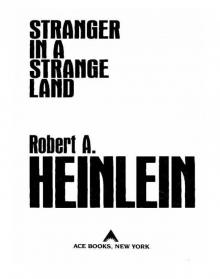 Stranger in a Strange Land
Stranger in a Strange Land The Worlds Of Robert A Heinlein
The Worlds Of Robert A Heinlein The Roads Must Roll
The Roads Must Roll Starship Troopers
Starship Troopers Farmer in the Sky
Farmer in the Sky The Past Through Tomorrow
The Past Through Tomorrow The Door Into Summer
The Door Into Summer All You Zombies
All You Zombies Friday
Friday Tomorrow, the Stars
Tomorrow, the Stars The Notebooks of Lazarus Long
The Notebooks of Lazarus Long The Moon Is a Harsh Mistress
The Moon Is a Harsh Mistress Beyond This Horizon
Beyond This Horizon Time Enough for Love
Time Enough for Love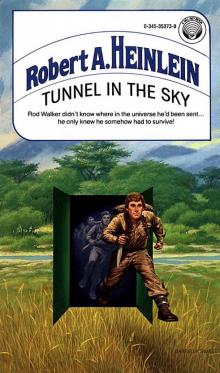 Tunnel in the Sky
Tunnel in the Sky Podkayne of Mars
Podkayne of Mars The Star Beast
The Star Beast The Cat Who Walks Through Walls
The Cat Who Walks Through Walls Grumbles From the Grave
Grumbles From the Grave Time for the Stars
Time for the Stars The Number of the Beast
The Number of the Beast The Unpleasant Profession of Jonathan Hoag
The Unpleasant Profession of Jonathan Hoag Sixth Column
Sixth Column To Sail Beyond the Sunset
To Sail Beyond the Sunset Revolt in 2100
Revolt in 2100 And He Built a Crooked House
And He Built a Crooked House The Pursuit of the Pankera: A Parallel Novel About Parallel Universes
The Pursuit of the Pankera: A Parallel Novel About Parallel Universes Expanded Universe
Expanded Universe Starman Jones
Starman Jones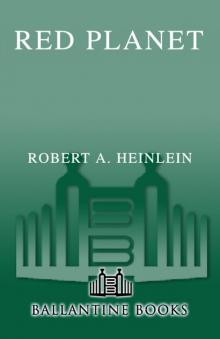 Red Planet
Red Planet Double Star
Double Star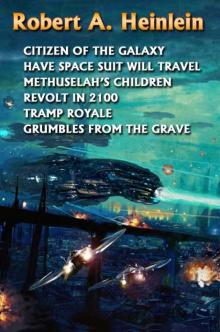 Citizen of the Galaxy
Citizen of the Galaxy Rocket Ship Galileo
Rocket Ship Galileo Glory Road
Glory Road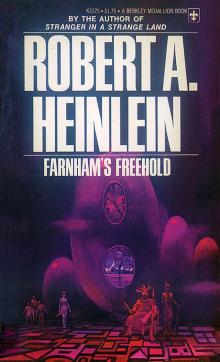 Farnham's Freehold
Farnham's Freehold Space Cadet
Space Cadet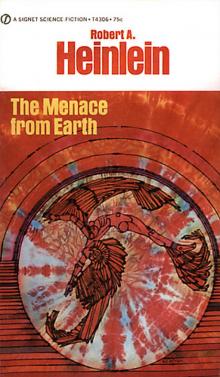 The Menace From Earth ssc
The Menace From Earth ssc Between Planets
Between Planets Methuselah's Children
Methuselah's Children Have Space Suit—Will Travel
Have Space Suit—Will Travel The Rolling Stones
The Rolling Stones Door Into Summer
Door Into Summer The Cat Who Walked Through Walls
The Cat Who Walked Through Walls Magic, Inc
Magic, Inc Off The Main Sequence
Off The Main Sequence Pied Piper
Pied Piper The Unpleasant Profession Of Jonathan Hoag And Other Stories
The Unpleasant Profession Of Jonathan Hoag And Other Stories Variable Star
Variable Star Waldo, and Magic, Inc
Waldo, and Magic, Inc Robert A. Heinlein: In Dialogue With His Century
Robert A. Heinlein: In Dialogue With His Century Waldo
Waldo Bulletin Board
Bulletin Board Job: A Comedy
Job: A Comedy Tramp Royale
Tramp Royale A Tenderfoot in Space
A Tenderfoot in Space For Us, the Living
For Us, the Living Destination Moon
Destination Moon Logic of Empire
Logic of Empire The Fantasies of Robert A. Heinlein
The Fantasies of Robert A. Heinlein The Menace From Earth
The Menace From Earth From the Notebooks Of Lazarus Long
From the Notebooks Of Lazarus Long Have Space Suit - Will Travel
Have Space Suit - Will Travel A Stranger in a Strange Land
A Stranger in a Strange Land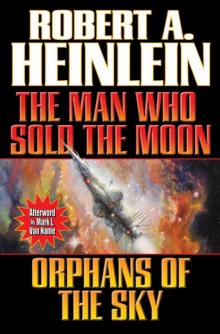 Man Who Sold the Moon / Orphans of the Sky
Man Who Sold the Moon / Orphans of the Sky